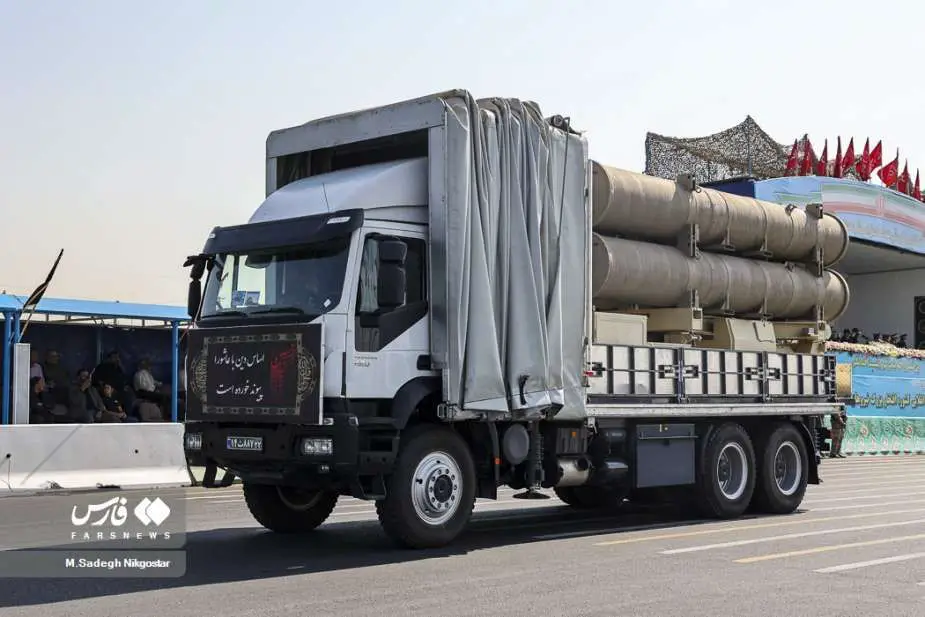Breaking News
Russia Receives Over 200 Fath 360 Ballistic Missiles from Iran.
According to "The Times", a British national newspaper, Russia has received a shipment of more than 200 ballistic missiles from Iran, a move that could have significant implications for the ongoing conflict in Ukraine. The report, published on September 6, 2024, suggests that the shipment includes Fath-300 missiles. However, military experts have clarified that there is no known Fath-300 missile, and the delivery likely involves the Fath-360 model. These ballistic missiles arrived via a Russian ship at an undisclosed port in the Caspian Sea, as revealed by a Ukrainian military source to "The Times".
Follow Army Recognition on Google News at this link

Fath 360 missiles mounted on a 6x6 truck displayed during a military parade in Tehran, Iran. (Picture source: Wikimedia)
This revelation highlights the deepening military cooperation between Iran and Russia, particularly regarding arms supplies. Since the start of the war in February 2022, Iran has provided Russia with significant military hardware, including drones and missiles, raising concerns about Tehran's role in the conflict. Notably, Iranian-made Shahed-136 drones, often referred to as "kamikaze drones," have been widely used by Russian forces to strike Ukrainian targets. These drones have been effective in their ability to evade detection, contributing to sustained air campaigns on Ukrainian cities and critical infrastructure.
While previous reports have primarily focused on the use of drones, this shipment of ballistic missiles marks a significant escalation in the arms trade between the two nations. The Fath-360 is an Iranian short-range ballistic missile (SRBM) known for its precision and mobility. With a range of approximately 120 to 300 kilometers, it is designed to carry out tactical strikes against various targets, including military installations and infrastructure. The missile is equipped with a solid-fuel engine, which allows for rapid deployment and quick launch times, making it a highly effective weapon on the battlefield.
The Fath-360 also boasts a relatively small and maneuverable design, making it more difficult for air defense systems to intercept. Its guidance system enables accurate strikes, adding to its tactical value for Russia in the ongoing conflict, where it can be used to target Ukrainian positions or strategic assets with greater precision than older missile systems.
The arrival of these missiles signals an increased reliance by Russia on foreign military assistance, especially as its war efforts have encountered stiff resistance from Ukrainian forces. It also underscores the broader geopolitical implications of Iran's involvement, despite Tehran's repeated denials of direct participation in the conflict. Western nations, particularly those in Europe and the United States, may view this missile shipment as further evidence of Iran's role in supporting the Russian invasion of Ukraine, potentially leading to increased diplomatic or economic sanctions against both countries.
As the conflict continues to evolve, the strategic use of Iranian ballistic missiles could shift the balance on the battlefield. Russia might deploy them against key Ukrainian military assets, aiming to weaken Ukrainian defenses and disrupt supply chains. This development also increases pressure on Ukraine to enhance its air defense capabilities to counter the growing threat of missile attacks.
In response to this new escalation, Western nations are likely to amplify their military support for Ukraine, possibly supplying advanced anti-missile systems to defend against these threats. Additionally, further shipments from Iran to Russia cannot be ruled out, given the ongoing partnership between the two countries, which has intensified throughout the war.
The transfer of Fath 360 ballistic missiles to Russia by Iran marks a pivotal moment in the conflict, as it signals a new phase of missile warfare that could have far-reaching consequences for Ukraine and its allies. The international community will be watching closely as these developments unfold, with the potential for further military, economic, and diplomatic actions to address the growing involvement of external actors in the Russian-Ukrainian war.


























